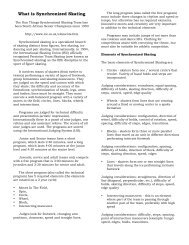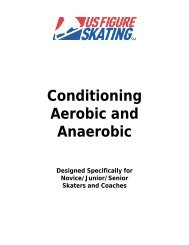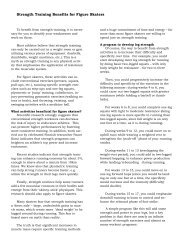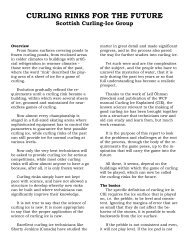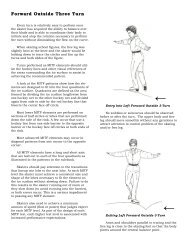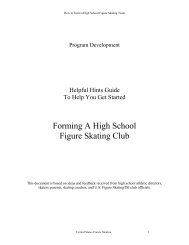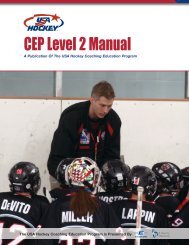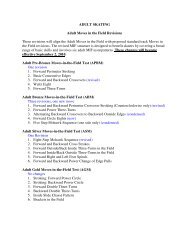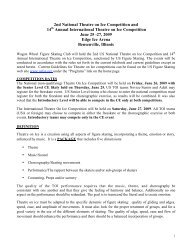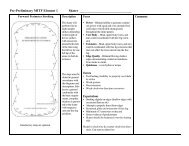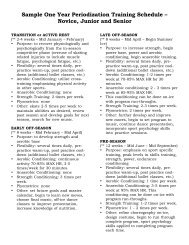CEP Level 3 Manual - Rushmore Hockey Association
CEP Level 3 Manual - Rushmore Hockey Association
CEP Level 3 Manual - Rushmore Hockey Association
Create successful ePaper yourself
Turn your PDF publications into a flip-book with our unique Google optimized e-Paper software.
T A B L E O F C O N T E N T SPROTECTIVE HOCKEY EQUIPMENTThe Superman SyndromeAvoid the “Superman Syndrome” on the ice,and get the best use out of today’s protectiveequipment.As good as it is, there isn’t any protectiveequipment that can keep a player from getting aserious spinal injury in a head-on collision with hishead down.But protective equipment can prevent or reduceconcussions, as well as facial, mouth and otherinjuries, so we’ve included guidelines for the propercare and maintenance of protective equipment.Look! Up in the sky! It’s a bird! It’s a plane…We spoke of reckless play as being “dumbhockey,” and it is. One factor leading to recklessplay may actually be the “can’t get hurt” feelingsome players get as a result of wearing protectiveequipment.So it’s worth your while to tell your players thatthe purpose of their protective equipment is toprotect them from sticks, pucks, skates, and otherobjects, not to allow them to skate recklessly.Maintaining Protective EquipmentHelmet• Make sure all helmets are HECC-certified.• Fit should be snug on top, back and sides ofthe head.• All padding and manufacturer’s hardwareshould be in place.• No cracks! Throw out a cracked helmetimmediately; it’s not only ineffective, it’sdangerous.• Neck strap should be working andcomfortable.Facial Protection• HECC-certified only.• If it’s a plastic shield, no cracks or scratches.• If it’s a wire cage, no bars bent or missing,and wire coating must be intact.• Chin cup should be in place, and chin shouldsit comfortably in it.• All straps and snaps should be in place andworking.Mouth Guard• Follow manufacturer’s instructions for properfit.• Make sure breathing is not inhibited when inplace.GETTING YOUR TEAM IN SHAPEHead and Neck ExercisesYou know the value of regular exercise andgeneral fitness to your players. In addition, a strongneck can actually help prevent head injuries. Wehope you’ll include these neck exercises in yourteam’s loosening up and strengthening routine, as avaluable addition to their “Heads Up <strong>Hockey</strong>”program.Players should complete this full routine fivetimes a week.Flexibility ExercisesAs a warm up exercise and to obtain fullmobility, isotonic exercises are repeated five timeseach in a sitting or standing position. Shoulders aredown and back in the starting position. Keep themthere.1. Drop your head sideways and hold it for aslow count of six. Push against the tension,but not too hard.2. Now drop it to the other side for a slow sixcount.3. Turn your head to one side for a slow countof six, pushing against the tension.4. Now reverse it and push to the other side.That’s one rep of this exercise. Repeat it fourmore times.Strengthening ExercisesStrengthening exercises are repeated five timeseach in a sitting position. They may be doneindividually or with a partner of similar size andstrength who resists the movements.1. Hands together behind your head. Pressagainst your hands for a slow count of six.2. Now keep pushing with your head, but easeyour hand’s resistance to tilt your head backslowly.3. One arm up, hand over your ear. Try to turnyour head to one side, but resist with yourhand. Hold for six.4. Now the same on the other side, for a slowcount of six.5. Now try to drop your head sideways, butresist for a slow count of six.6. Change sides, press and hold for a slow sixagain.7. Both arms in front, head in your hands. Pushwith your head and resist with your hands fora slow count of six.8. Same position, but let your head moveforward against your hands, slowly. Nowrepeat this whole exercise four more times.WHAT TO DO IF A PLAYER GETS HURTYou’re a coach, not a doctor. But sometimes you need tomake a medical decision on the spot.One of those situations is deciding whether ornot to take a player out of a game after he or she hashad a head impact. In the case of a concussion,your judgment is important, because even a mildconcussion can have serious consequences.Identifying and Dealing with a Spinal InjuryIn the case of a potential spinal injury, yourimmediate care and attention can make a bigdifference in the player’s well-being until medicalcare arrives.If you think a player may have sustained a spinalinjury, your immediate role is to get help and keepthe player calm and immobile. After a spinal impact,look for these symptoms:• pain in the area of the injury• buzzing or tingling in the arms and/or legs• loss of movement in the arms or legs• radiating pain in the arms or legsAfter calling for immediate medical help, givecare as follows:• Ensure adequate airway and breathing.• Observe the ABC’s: airway, breathing andcirculation.• Reassure the player.• Do not allow the player to move. Instruct theplayer not to move, and immobilize him orher to prevent any motion.• Keep the player warm.Identifying and Dealing with a ConcussionWe’ve adapted the following guidelines fromthe Colorado Medical Society Sports MedicineCommittee, developed in 1991. These are notintended to be used as medical diagnoses.They can help you judge the presence orabsence of a concussion, and if present, its severity,as well as letting you know how to deal withappropriately.Grade 1 Concussion• Confusion without amnesia• No loss of consciousnessThis is the most common form of concussion incontact sports, commonly called a “ding” or “havingyour bell rung.”Guideline for return to play: Remove theplayer from activity. Examine him or herimmediately and every five minutes thereafter forthe development of amnesia or post-concussionsymptoms both at rest and with exertion. Let theplayer return to play if neither amnesia norconcussion appear for at least twenty minutes.Grade 2 Concussion• Confusion with amnesia• No loss of consciousnessGuideline for return to play: Remove theplayer for the remainder of the game or practice,and seek medical help. Examine him or herfrequently for signs of developing symptoms. Reexaminethe next day. Let the player return topractice only after one full week without symptoms.Grade 3 Concussion• Loss of consciousnessGuideline for return to play: Seek medical helpimmediately for transport from rink by ambulance64 | USA <strong>Hockey</strong> Coaching Education Program <strong>Level</strong> 3 <strong>Manual</strong>Risk Management | 65



